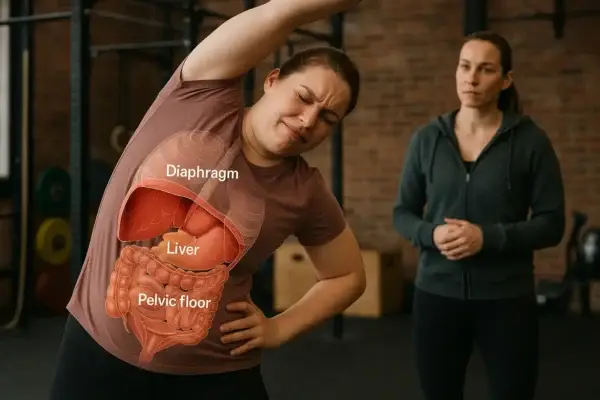
Hey, Everybody, it’s Ekemba from SolCore Fitness. Not every exercise that feels great is good for your body. Why? Because most of us don’t have total access to or awareness of our bodies—especially in areas impacted by old injuries, tension, or imbalances. We work out to “gain access,” to really feel and balance the full system. But until then, “feeling good” during exercise can be misleading and even risky.
Case Study: Why “Feeling Good” Can Backfire
A member joined us after an accident left her liver inflamed. We developed a targeted approach—balancing her diaphragm, pelvis, and surrounding fascial chains. She made progress. Over the weekend, she did some group stretching that “felt fantastic” at the time, especially side bends. Unfortunately, her liver was still sensitive. That movement, though pleasant, compressed and stressed her liver, triggering pain. What felt good wasn’t actually safe for her physiology.
Many people make a similar mistake in their own fitness routines—picking only exercises that feel good, or only the ones they prefer. Negative consequences might not show up right away, but over years, hidden imbalances can lead to joint wear, pain, or dysfunction.
The Science: True Body Balance and Awareness
Real body wisdom comes from training all structures, knowing what each area needs, and learning to listen to subtle feedback—not just chasing what feels comfortable. Diaphragm, pelvic floor, and fascial connections are especially complex. Their health is linked to proper breathing, mindful movement, and core integration—not just one “feel good” activity.
Balanced programs involve:
- Coaching and assessment to identify weaknesses and risks.
- Progressions that cultivate both mobility and stability.
- Full-body movement routines (not just “favorite” exercises) to align and wake up all structures.
Take Action: Train for Whole-Body Balance
Start simple: build body awareness, learn proper breathing (including diaphragmatic breathing), and work with a professional to develop correct patterns and progressions. Don’t trust just your instincts—trust evidence-based programs and feedback.
Dive deeper into safe, balanced fitness routines and how to truly educate your body:
Segmental Muscle Strengthening
Find out more @

Leave a Reply